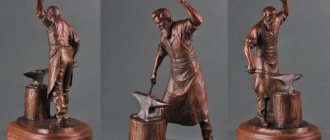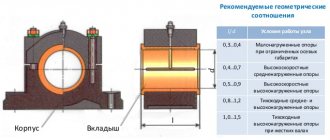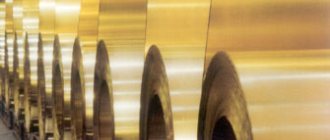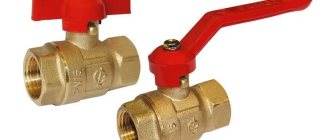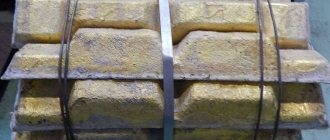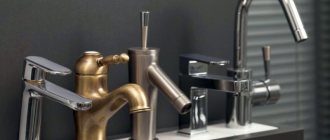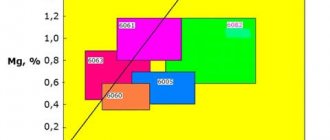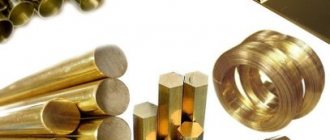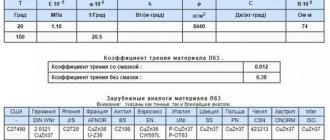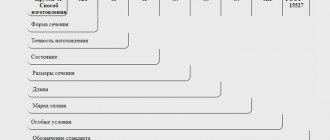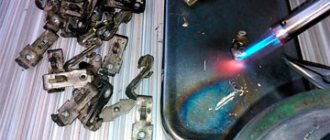What is bronze
Bronze is an alloy of copper, where the main alloying component can be various metals and non-metals. The properties of alloys significantly depend on the ratio of components and their qualities, as well as the phase composition of the melt.
Metal has a lot of excellent properties, both user-friendly and decorative. And today we will look at the composition of the alloy, types, grades of bronze and their application, a brief description of the properties of the material and its characteristics, as well as the difference between bronze and brass.
Do you want to melt bronze to make products? Then this video will help you:
Concept and features
The oldest known composition includes copper and tin, as well as other components, the content of which is insignificant. The alloy is marked in accordance with its composition, while the proportion of copper is not indicated, but can be calculated from the content of other components.
Thus, the brand BrAMTS-7-1 means that we are talking about bronze, which contains 7% aluminum and 1% manganese. Accordingly, the alloy contains 92% copper, and no tin at all, that is, this is a grade of tin-free bronze.
Depending on the amount of impurities, the alloy may have a different color. A material where the share of copper is more than 90% has a reddish color, up to 85% is yellow, and an alloy with a copper share of 35% has a steel-gray color.
But, more importantly, the ratio of components determines the properties of the alloy. Thus, red bronze with a tin content of 2% is characterized by very high ductility; it can be forged at normal temperatures. And the material containing 15% tin becomes hard and durable: in ancient times such an alloy was used to make weapons.
These properties - ductility and hardness, depending on the combination of ingredients - determined the two most important historical uses of the alloy - art and war. Edged weapons, cannonballs, and the guns themselves were cast from bronze. But it was also used to create the most beautiful sculptures and jewelry that are the property of the whole world.
Modern alloys have a more complex composition and include the most unusual components. In this way, alloys are obtained that are suitable for a variety of purposes - from electrical engineering to plumbing. Their common property is that the base remains copper.
2 copper alloys, however, have nothing to do with bronze: brass - an alloy of copper and zinc, and cupronickel - with nickel. Brass is noticeably inferior to bronze in terms of corrosion resistance and hardness. This alloy is ductile and retains excellent ductility under a wide range of compositions. And if in art preference is given to bronze, then in jewelry, brass wins.
Advantages and disadvantages
Such a long-standing popularity and long-term use of the material can only be explained by the mass of its excellent qualities. It is also possible to change these qualities by using another component as an alloying additive.
- Diversity is one of the best properties of a material. Tin, aluminum, silver, beryllium bronzes are used extremely widely in the most unexpected areas, since the addition of other metals gives the composition completely different qualities. Thus, most bronze alloys conduct electricity relatively poorly. The same cannot be said about silver bronze: with a fraction of just 0.25% silver, the alloy conducts current no worse than copper.
- Bronze compositions can be cast or deformable. That is, for certain purposes it is possible to obtain an alloy that can be cold forged - deformed at normal temperature - and an alloy that can be cast.
- Bronze castings give minimal shrinkage - from 0.5 to 1.5%. This property explains the popularity of the material not only among sculptors, but also in the field of instrument and machine tool construction.
- Bronze is a material that can be used a second, third, and fourth time. The alloy tolerates repeated melting very well.
- The alloy is safe. While some components during its manufacture may be dangerous - beryllium, for example, then the finished material is completely non-toxic.
- It is characterized by exceptional corrosion resistance: neither urban polluted air nor sea water cause deformation of the material or a decrease in its quality. Bronze is not even susceptible to the action of most acids, so it is often used in the manufacture of acid-resistant equipment.
- Another interesting quality of many alloys is high elasticity. The material is used in the manufacture of a variety of high-precision springs that are characterized by durability.
The disadvantages of the alloy include its cost. Copper, and even more so tin, are relatively common metals, but expensive to obtain. Other types of bronze - aluminum, for example, cost much less, since the alloying component is a more affordable material.
The low thermal conductivity of most alloys can also be considered a disadvantage. However, this quality has also found application - in the manufacture of bathroom accessories or the bathtubs and washbasins themselves.
Varieties
Bronze is distinguished according to several characteristics, indicating its composition and more characteristic properties.
According to the composition they are distinguished:
- tin - alloys can be two- or multi-component. However, tin remains the second largest ingredient here;
- tin-free - all others: aluminum, beryllium, silicon, lead and so on. Each of the components gives bronze some properties. Thus, beryllium provides the material with exceptional elasticity and very high wear resistance, and the addition of silicon provides anti-friction properties.
By application, bronzes are distinguished as follows:
- deformable - alloys are easily forged, they can be rolled, forged, cut;
- molded - products are produced by casting, since it is deformed only at high temperatures. The alloy is used to produce castings of the most complex configurations.
A more specific division of bronzes is related to the structure:
- single-phase - components in a solid solution form one phase;
- two-phase 2 phases appear in the solution, which usually leads to a radical change in properties.
Read below about the basic properties, mechanical characteristics of bronze and the difference in the chemical composition of this metal from brass.
Conformity of tin bronze grades according to GOST 613-79 and the replaced GOST 613-65
| Bronze grades according to GOST 613-79 | Bronze grades according to GOST 613-65 | Bronze grades according to GOST 613-79 | Bronze grades according to GOST 613-65 |
| Brozts12S5 | BrOTsSZ-12-5 | BrO6TS6SZ | — |
| BroZTS7S5N1 | BrOTsSNZ-7-5-1 | BrO8TS4 | — |
| BrO4TS7S5 | BrOTsSZ,5-7-5 | BrO10F1 | — |
| BrO4Ts4S17 | BrOTsS4-4-17 | BrO10TS2 | — |
| BrO5TS5S5 | BrOTs5-5-6 | BrO10S10 | — |
| BrO5S25 |
Properties and characteristics
Tin bronzes are more common in the national economy. As a rule, when describing the properties, the parameters of cast tin are indicated, since a larger number of products are produced using this method.
The main technical characteristics of the alloy include the following qualities:
- density – determined by the mass fraction of tin. So, with its content from 8 to 4%, the density varies from 8.6 to 9.1 kg/cu. cm;
- depending on the composition of the alloy, its melting point varies from 880 to 1060 C;
- tin bronze conducts heat poorly - from 0.098 to 0.2 cal/(cm*s*C);
- heat capacity averages 0.385 kJ / (kg*K);
- the electrical conductivity of most bronzes is also not too high and is significantly less than that of copper: the electrical resistivity value is 0.087–0.176 μOhm*m;
- the material corrodes very slowly both in air and in contact with water. Thus, the corrosion rate in air is 0.002 mm/year, and in sea water – 0.04 mm/year.
About what metals and what else is included in the composition of bronze, what is its formula and chemical. Contents, find out below.
This video will tell you how to paint metal “bronze”:
Physical properties of tin bronzes processed by pressure
| Brand | Melting point, °C | Density γ, kg/m3 | Electrical resistivity ρ*106, Ohm*m | Thermal conductivity λ, W/(m*K) | Specific heat capacity сp, J/(kgK) | Temperature coefficient of linear expansion α*106, K-1 |
| BrOF4-0.25 | 1080 | 8900 | 0,091 | 83,6 | — | 17,6 |
| BrOF6.5-0.15 | 995 | 8850 | 0,123 | 71 | 377 | 17,8 |
| BrOF6.5-0.4 | 955 | 8850 | 0,176 | 67 | 377 | 17,1 |
| Br0f7-0.2 | 950 | 8750 | 0,17 | 65,8 | 377 | 17 |
| BrOF8-0.3 | 880 | 8700 | 0,175 | 63 | 377 | 17 |
| BrOTs4-3 | 1045 | 8800 | 0,087 | 83,5 | — | 18 |
| BrOTsS4-4-2.5 | 1018 | 8900 | 0,09 | 70,7 | 377 | 18,2 |
| BrOTsS4-4-4 | 1015 | 9100 | 0,11 | 67 | — | 18,1 |
Structure and composition
- The properties of the alloy - from color to fluidity in molten form - depend on two main factors: the qualitative composition of bronze and its structure. A qualitative composition is a set of metals or non-metals involved in creating an alloy in a tangible, significant amount. Moreover, the latter is determined not by the actual mass or volume of the substance, but by the severity of the properties that it creates. The addition of only 0.25% silver significantly increases electrical conductivity, and to obtain anti-friction properties you need to add at least 4% silicon.
The composition is indicated on the labeling, which allows you to choose the right material for certain jobs.
- The second factor is less known - the structure of the alloy or solid solution . The fact is that only 15.8% of tin can dissolve in copper, while in the alloy there can be noticeably more of it. This causes the appearance of alloys with different phase structures. Single-phase - the proportion of tin does not exceed 6–8%; there is only one α-phase. This composition is characterized by elasticity and high malleability. Moreover, bronze with a tin content of up to 2% can be forged in the cold without heating, and with a metal content of up to 8% - with heating.
- Two-phase - when the tin fraction exceeds 15%, that is, the maximum solubility, 2 phases appear in the solid solution. At the same time, such a quality as malleability completely disappears, and the alloy begins to gain hardness and some fragility. This alloy is used for casting.
Additional elements that influence the properties have little effect on the phase composition.
Cold-rolled strips and tapes made of tin bronze. Mechanical properties
| Products, GOST | Brand | Delivery status | Thickness, mm | Tensile strength σb, MPa | Relative elongation δ10,% |
| Within or no less | |||||
| Strips and ribbons made of tin-phosphorus tin-zinc bronze, GOST 1761-92 | BrOF6.5-0.15 | soft | less than 0.5 | 290 | 35 |
| 0.5 or more | 38 | ||||
| semi-solid | less than 0.5 | 440…570 | 8 | ||
| 0.5 or more | 10 | ||||
| hard | less than 0.5 | 570…740 | 3 | ||
| 0.5 or more | 5 | ||||
| extra hard | less than 0.5 | 740 | — | ||
| 0.5 or more | — | ||||
| BrOTs4-3 | soft | less than 0.5 | 290 | 35 | |
| 0.5 or more | 38 | ||||
| semi-solid | less than 0.5 | 350…540 | 4 | ||
| 0.5 or more | 8 | ||||
| hard | less than 0.5 | 540…690 | 2 | ||
| 0.5 or more | 4 | ||||
| extra hard | less than 0.5 | 660 | — | ||
| 0.5 or more | — | ||||
| Tapes and strips made of tin-zinc-lead bronze, GOST 15885-77 | BrOTsS4-4-2.5 | soft | from 0.50 to 3.00 | 290 | 35 |
| semi-solid | 390…490 | 10 | |||
| hard | 540 | 5 | |||
Production of material
Bronze is obtained from pure metals or alloys in ingots. The second is more common, as it is cheaper and allows you to get any cast bronze.
- The first stage is the extraction of copper and tin from the deposits. Tin is found in cassiterites, stannines, and so on. Copper is more common: it is mined from native copper and many minerals - chalcopyrite, bornite, chalcocite. The metal is isolated in several different ways, of which pyrometallurgical, that is, oxidative annealing and fire refining, is the most common.
- Then the composition of the charge is calculated: it depends on the composition of the future product and on the production method - from secondary alloys, from metal and secondary alloys, and so on.
- Melting itself, for example from pigs, includes several stages:
- loading - the material is loaded into dried and heated graphite-carboride or graphite-chamotte crucibles. Electric and electric arc furnaces are best suited as they allow melting to be carried out as quickly as possible. This is important because when melting metals, there is a high probability of gases being absorbed into the melt;
- melting - first of all, copper is melted, and then various components are added that improve the mechanical properties of the alloy, and basic alloying additives;
- overheating - the melt is heated to 1200 C under a layer of charcoal. If the source metals are contaminated, liquid salt fluxes are used;
- degassing - the melt is cleaned of gas impurities by blowing with argon or nitrogen.
- Castings are obtained from the finished alloy. Most often, gating systems are used for this. Casting is done in clay or metal molds. It is possible to produce castings using centrifugal casting.
In 2016, there was an increase in prices for copper - up to 4%, and tin - up to 10.3%. Accordingly, the cost of products made from bronze and bronze scrap increases. The latter in October had a cost from 190 to 210 rubles. per kg.
The price of products - rod, casting, sheet - depends on the composition of the alloy. So, a rod of different brands can be purchased for both 308 and 803 rubles. per kg.
Next we touch on the marking and use of bronze.
Tin bronzesTin bronzes are alloys of copper and tin (Fig. 1), as well as more complex copper-tin alloys with the addition of phosphorus, zinc, lead, nickel and other elements. The chemical composition of tin bronzes is given in table. 1.
Rice.
1. State diagram of the Cu-Sn system Chemical composition of tin bronzes (GOST 5017-2006) (mass fraction, %)
| Brand | Element content limit | Element | Sum of other elements | ||||||||||
| Cu | Al | Bi | Fe | Ni | R | Pb | Sb | Si | Sn | Zn | |||
| BrOF8-0.3 | min. | ost. | — | — | — | — | 0,26 | — | — | — | 7,5 | — | — |
| Max. | — | 0,002 | 0,002 | 0,02 | 0,2 | 0,35 | 0,02 | 0,002 | 0,002 | 8,5 | 0,3 | 0,1 | |
| BrOF7-0.2 | min. | ost. | — | — | — | — | 0,1 | — | — | — | 7 | — | — |
| Max. | — | 0,002 | 0,002 | 0,05 | 0,2 | 0,25 | 0,02 | 0,002 | 0,005 | 8 | 0,3 | 0,1 | |
| BrOF6.5-0.4 | min. | ost. | — | — | — | — | 0,26 | — | — | — | 6 | — | — |
| Max. | — | 0,002 | 0,002 | 0,02 | 0,2 | 0,4 | 0,02 | 0,002 | 0,005 | 7 | 0,3 | 0,1 | |
| BrOF6.5-0.15 | min. | ost. | — | — | — | — | 0,1 | — | — | — | 6 | 0,3 | — |
| Max. | — | 0,002 | 0,002 | 0,05 | 0,2 | 0,25 | 0,02 | 0,002 | 0,002 | 7 | — | 0,1 | |
| BrOF4-0.25 | min. | ost. | — | — | — | — | 0,2 | — | — | — | 3,5 | 0,3 | — |
| Max. | — | 0,002 | 0,002 | 0,02 | 0,2 | 0,3 | 0,02 | 0,002 | 0,002 | 4 | — | 0,1 | |
| BrOF2-0.25 | min. | ost. | — | — | — | — | 0,02 | — | — | — | 1 | 0,3 | — |
| Max. | — | — | — | 0,05 | 0,2 | 0,3 | 0,03 | — | — | 2,5 | — | 0,3 | |
| BrOTs4-3 | min. | ost. | — | — | — | — | — | — | — | — | 3,5 | 2,7 | — |
| Max. | — | 0,002 | 0,002 | 0,05 | 0,3 | 0,03 | 0,02 | 0,002 | 0,005 | 4 | 3,3 | 0,2 | |
| BrOTsS4-4-2.5 | min. | ost. | — | — | — | — | — | 1,5 | — | — | 3 | 3 | — |
| Max. | — | 0,002 | 0,002 | 0,05 | 0,3 | 0,03 | 3,5 | 0,002 | — | 5 | 5 | 0,2 | |
| BrOTsS4-4-4 | min. | ost. | — | — | — | — | — | 3,5 | — | — | 3 | 3 | — |
| Max. | — | 0,002 | 0,002 | 0,05 | 0,3 | 0,03 | 4,5 | 0,002 | — | 5 | 5 | 0,2 | |
| Notes: | |||||||||||||
| 1. In bronze grade BrS)F6.5-0.15, a mass fraction of tin of up to 7.5% is allowed. | |||||||||||||
| 2. In BrOTs4-3 grade bronze, the mass fraction of titanium is allowed to be no more than 0.12% due to the mass fraction of copper, which is not taken into account in the total amount of other elements. | |||||||||||||
| 3. In alloys used for the manufacture of products with antimagnetic properties, the mass fraction of iron is allowed to be no more than 0.02%. The letter A is added to the brand designation. | |||||||||||||
| 4. Mass fractions of sulfur and magnesium impurities are allowed no more than 0.007% each. | |||||||||||||
| 5. The sign “—”, placed simultaneously for the upper and lower limits of the mass fraction of an element, means that this element is not standardized and is determined only at the request of the consumer, and in this case the content of this impurity is included in the total amount of other elements. | |||||||||||||
| 6. An element for which only the maximum limit of its content is indicated should be considered an impurity. | |||||||||||||
| 7. Impurities not listed in this table are taken into account in the total amount of other elements. | |||||||||||||
Mechanical properties
With increasing tin content, the strength and hardness of tin bronzes increases; at the same time, ductility and impact strength decrease (Fig. 2).
Rice. 1. The influence of tin content on the mechanical properties of tin bronzes
Temporary resistance reaches maximum values at 10...12% Sn. Hardness and yield strength also increase with higher tin content, but at the same time, elongation and impact strength decrease. Tin bronzes containing up to 10% Sn (see Table 1) with additions of phosphorus, zinc or lead can be plastically deformed.
Alloying elements in tin bronzes
Phosphorus is considered an alloying element if its content in tin bronze exceeds 0.1%.
The introduction of phosphorus into tin bronzes serves several purposes. Firstly, it deoxidizes copper. In non-deoxidized tin bronzes, oxygen may be present in the form of SnO2 oxide. This very hard and brittle compound sharply reduces the technological and operational properties of tin bronzes. Secondly, phosphorus increases strength properties. In bronzes with a small amount of tin, phosphorus increases wear resistance due to the appearance of solid dispersed particles of copper phosphide Cu3P in the structure. However, phosphorus impairs the technological ductility of tin bronzes, so its content in wrought alloys must be strictly regulated.
Tin bronzes with a phosphorus content of 0.5% or more are easily destroyed during hot deformation due to the melting of the phosphide eutectic (α+ Cu3P); the maximum phosphorus content in pressure-processed tin bronzes is 0.4% (see Table 1). With this phosphorus content, deformable tin bronzes have optimal mechanical properties, have increased values of the normal elastic modulus and elastic limit, as well as high resistance to fatigue failure. Tin-phosphorus bronzes Br0F6.5-0.15, Br0F6.5-0.4, Br0F7-0.2 and Br0F8-0.3 are similar in chemical composition and are distinguished by high mechanical, anti-corrosion and anti-friction properties.
Bronze Br0F6.5-0.15 has high strength and elasticity after deformation and is used for the manufacture of springy parts of devices. Bronze BrOF6.5-0.4, given its high wear resistance, is used for the manufacture of meshes in the pulp and paper industry. Bronze Br0F7-0.2 has high mechanical properties at room and elevated temperatures and is mainly used in the form of pressed rods.
The wear resistance of bronze can be increased by cold deformation. Bronze BrOF8-0.3 is superior to bronze BrOF7-0.2 in terms of the combination of strength properties and wear resistance.
To increase the strength properties of tin bronzes that do not contain phosphorus, they are alloyed with zinc in large quantities, but within the limits of its solubility in the α-phase.
Bronze BrOTs4-3 has good mechanical corrosion properties; it is used in the electrical industry, mechanical engineering, instrument making and precision mechanics for the manufacture of springs, fittings and other parts. Bronze deforms well when hot and cold.
Zinc is often added to tin bronzes together with lead (see Table 1). Lead is practically insoluble in tin bronzes in the solid state. The structure of tin-zinc-lead bronzes BrOTsS4-4-2.5 and BrOTsS4-4-4 consists of α-solid solution crystals and lead inclusions. Lead improves the anti-friction properties and increases the machinability of tin bronzes. However, the mechanical properties of tin bronzes are noticeably reduced under the influence of lead.
Bronze BrOTsS4-4-2.5 and BrOTsS4-4-4, containing lead, are processed by pressure only in a cold state, since due to the presence in the structure of these alloys of low-melting eutectic, consisting of almost pure lead, hot pressure treatment is impossible. These bronzes have high antifriction properties, are corrosion-resistant, and can be easily machined; Tapes and strips are made from them, and are also used as gaskets in bearings and bushings.
An important alloying element in tin bronzes is nickel, which increases the strength properties, ductility and deformability of tin bronzes, their corrosion resistance, and refines the grain due to the formation of intermetallic compounds Ni3Sn2 and Ni3Sn. These phases have a variable solubility in the α-solid solution that sharply decreases with decreasing temperature; therefore, tin bronzes with nickel are thermally strengthened by hardening and aging.
An important characteristic of deformable tin bronzes is their high fatigue strength in corrosive environments. Fatigue strength increases with increasing tin content to 4%, and then increases to a lesser extent.
Heat treatment.
Homogenization, intermediate and final annealing are the main types of heat treatment of tin bronzes in order to increase their ductility. The temperatures of hot deformation and annealing of deformed tin bronzes are given in table. 2.
| Table 2. Technological properties and processing temperatures of tin bronzes | ||||||
| Brand | Cutting machinability2,% | Fluidity, mm | Linear shrinkage, % | Temperature, °C | ||
| casting | hot deformation | annealing | ||||
| BrOF4-0.25 | 20 | — | 1,4 | 1250…1300 | 700… 850 | 600…650 |
| BrOF6.5-0.15 | 20 | — | — | 1150…1250 | 750… 850 | 600…700 |
| BrOF6.5-0.4 | 20 | 1170 | 1,45 | 1150…1250 | 750…770 | 600…700 |
| Br0f7-0.2 | 16 | — | — | 1170…1250 | 750…800 | 600…720 |
| BrOF8-0.3 | — | — | — | 1150…1250 | 680…750 | 600…720 |
| BrOTs4-3 | 20 | 200 | 1,45 | 1200…1250 | 750…850 | 600…700 |
| BrOTsS4-4-2.51 | 90 | 200 | 1,49 | 1150…1200 | — | 500…600 |
| BrOTsS4-4-4 | 90 | 250 | — | 1150…1200 | — | 600…700 |
| 1 Processed by pressure only in a cold state with a deformation of 30%. | ||||||
| 2B% relative to the machinability of brass LS63-3. | ||||||
Tin bronzes are copper alloys that require homogenization annealing to obtain high-quality deformed products. In alloys of the Cu-Sn system, due to the large crystallization interval (see Fig. 1), the compositions of the liquid and solid phases differ significantly from each other, which contributes to dendritic liquation. Subsequent heating of the ingots under hot pressure treatment and plastic deformation cannot completely eliminate the chemical heterogeneity of the solid solution in tin bronzes.
As a result of homogenization annealing of tin bronzes, the homogeneity of their structure increases; nonequilibrium intermetallic phases dissolve in the solid solution, and the chemical composition is leveled across the cross section of the crystallites in the ingot. Homogenization annealing of tin bronze ingots is carried out at temperatures of 700...750°C, followed by rapid cooling. The annealing temperature and time must be sufficient to eliminate the consequences of segregation. Intermediate and final annealing during cold working is carried out at temperatures of 500...650°C; in this case, the hardening caused by cold plastic deformation of tin bronzes is completely eliminated (Fig. 3).
Corrosive properties.
Tin bronzes have good corrosion resistance; the corrosion rate of bronzes containing 5...8% Sn does not exceed 0.002 mm/year.
In seawater, tin bronzes are more corrosion resistant than copper and brass, and the resistance of bronzes increases with increasing tin content. Nickel also increases the corrosion resistance of tin bronzes in seawater, while lead, at a high content, decreases it.
The corrosion rate of wrought tin and some cast bronzes in sea water is (mm/year):
| BrO10F1…..… 0.016 | BrOF6.5-4…….. 0.04 |
| BrO10Ts2…….. 0.018 | BrOF4-0.25……0.016 |
| BrO6Ts3N3……0.005 | BrOTs4-3………… 0.022 |
| BrO6Ts6S3…… 0.028 | BrOTs4-4-2.5…. 0.016 |
Tin bronzes are unstable in the environment of mineral acids, alkalis, ammonia, cyanides, ferrous and sulfur compounds of acidic mine waters. Of the minerals, hydrochloric and nitric acids have the greatest effect on tin bronzes; sulfur is less aggressive in this regard. However, the rate of corrosion of tin bronzes under the influence of sulfuric acid increases in the presence of oxidizing agents (K2Cr2O7, Fe2(S04)3, etc.). In the presence of inhibitors, for example, 0.05% benziothiocyanite, the corrosion rate of tin bronzes decreases by 10...15 times.
The physical, mechanical and technological properties of deformed tin bronzes are given in table. 2 - 6. The areas of application of tin bronze products are given in table. 7.
| Table 3. Physical properties of tin bronzes processed by pressure | ||||||
| Brand | Melting point, °C | Density γ, kg/m3 | Electrical resistivity ρ*106, Ohm*m | Thermal conductivity λ, W/(m*K) | Specific heat capacity сp, J/(kgK) | Temperature coefficient of linear expansion α*106, K-1 |
| BrOF4-0.25 | 1080 | 8900 | 0,091 | 83,6 | — | 17,6 |
| BrOF6.5-0.15 | 995 | 8850 | 0,123 | 71 | 377 | 17,8 |
| BrOF6.5-0.4 | 955 | 8850 | 0,176 | 67 | 377 | 17,1 |
| Br0f7-0.2 | 950 | 8750 | 0,17 | 65,8 | 377 | 17 |
| BrOF8-0.3 | 880 | 8700 | 0,175 | 63 | 377 | 17 |
| BrOTs4-3 | 1045 | 8800 | 0,087 | 83,5 | — | 18 |
| BrOTsS4-4-2.5 | 1018 | 8900 | 0,09 | 70,7 | 377 | 18,2 |
| BrOTsS4-4-4 | 1015 | 9100 | 0,11 | 67 | — | 18,1 |
| Table 4. Cold-rolled strips and tapes made of tin bronze. Mechanical properties | |||||
| Products, GOST | Brand | Delivery status | Thickness, mm | Tensile strength σb, MPa | Relative elongation δ10,% |
| Within or no less | |||||
| Strips and ribbons made of tin-phosphorus tin-zinc bronze, GOST 1761-92 | BrOF6.5-0.15 | soft | less than 0.5 | 290 | 35 |
| 0.5 or more | 38 | ||||
| semi-solid | less than 0.5 | 440…570 | 8 | ||
| 0.5 or more | 10 | ||||
| hard | less than 0.5 | 570…740 | 3 | ||
| 0.5 or more | 5 | ||||
| extra hard | less than 0.5 | 740 | — | ||
| 0.5 or more | — | ||||
| BrOTs4-3 | soft | less than 0.5 | 290 | 35 | |
| 0.5 or more | 38 | ||||
| semi-solid | less than 0.5 | 350…540 | 4 | ||
| 0.5 or more | 8 | ||||
| hard | less than 0.5 | 540…690 | 2 | ||
| 0.5 or more | 4 | ||||
| extra hard | less than 0.5 | 660 | — | ||
| 0.5 or more | — | ||||
| Tapes and strips made of tin-zinc-lead bronze, GOST 15885-77 | BrOTsS4-4-2.5 | soft | from 0.50 to 3.00 | 290 | 35 |
| semi-solid | 390…490 | 10 | |||
| hard | 540 | 5 | |||
| Note: product hardness is not regulated. | |||||
| Table 5. Tin bronze rods and wires. Mechanical properties | |||||||
| Products, GOST | Brand | Manufacturer | Comp. fast. | Diameter, mm | Tensile strength σb, MPa | Relative elongation δ10,% | NV |
| No less | |||||||
| Tin-zinc bronze rods, GOST 6511-60 | BrOTs4-3 | T | — | from 5 to 12 incl. | 430 | 10 | — |
| from 13 to 25 incl. | 370 | 12 | — | ||||
| from 26 to 35 incl. | 330 | 14 | — | ||||
| from 36 to 40 incl. | 310 | 16 | — | ||||
| Etc | — | from 42 to 120 incl. | 270 | 25 | — | ||
| Tin-phosphorus bronze rods, GOST 10025-78 | BrOF6.5-0.15 | T, HK | m | from 5 to 20 incl. | 350 | 40 | 70 |
| Fri | 390 | 18 | 120 | ||||
| TV | 470 | 12 | 140 | ||||
| FROM | 550 | 6 | 150 | ||||
| Etc | — | from 100 to 110 incl. | 340 | 55 | 70 | ||
| Br0f7-0.2 | T, HK | M | from 16 to 40 incl. | 390 | 40 | 80 | |
| PT | 440 | 15 | 130 | ||||
| TV | 520 | 10 | 150 | ||||
| FROM | 570 | 6 | 180 | ||||
| Etc | — | from 40 to 95 incl. | 360 | 55 | 70 | ||
| Tin-zinc bronze wire, GOST 5221-77 | BrOTs4-3 | HD, T | TV | from 0.1 to 2.5 incl. | 880 | 0,5 | — |
| St. 2.5 to 4.0 incl. | 830 | 1 | — | ||||
| St. 4.0 to 8.0 incl. | 814 | 1 | — | ||||
| St. 8.0 to 12.0 incl. | 765 | 2 | — | ||||
| Legend: | |||||||
| T - pulled; Pr - pressed; ХК - cold rolled; HD - cold-deformed; M - soft; PT - semi-solid; TV - solid | |||||||
| Table 6. Pipes drawn from tin bronze. Mechanical properties | |||||
| Products, GOST | Brand | Dimensions, mm | Tensile strength σb, MPa | Relative elongation δ10,% | |
| Diameter | Wall thickness | No less | |||
| Manometric pipes made of tin-phosphorus bronze, GOST 2622-75 | BrOF 4-0.25 | from 8.0 to 22.0 incl. | from 0.20 to 1.60 incl. | 490 | 3 |
| Note: product hardness is not regulated. | |||||
| Table 7. Application areas of tin bronze products | |
| Brand | Products and Applications |
| BrOF2-0.25 | sheets, tape, wire, flexible hose tapes, conductive parts, screws, welding filler material |
| BrOF4-0.25 | strips, sheets, tubes in apparatus construction and for instrumentation, pressure gauge tubes |
| BrOF6.5-0.15 | sheets, strips, rods, membranes, spring contacts, bearing parts, blank pipes for bimetallic steel-bronze bushings |
| BrOF7-0.2 | rods for various purposes, parts subject to friction at medium loads and sliding speeds, antifriction washers, gears, cogwheels |
| BrOF8.0-0.3 | wire for mesh in the pulp and paper industry, piston ring belts |
| BrOFb,5-0.4 | wire for mesh in the pulp and paper industry, as well as for springs; tapes and strips for mechanical engineering |
| BrOTs4-3 | tape, strips, rods, wire for springs and chemical industry equipment, plug contacts |
| BROTS4-4-2.5 | tapes and strips for gaskets in bushings and bearings |
| BROTSS4-4-4 | tapes and strips for gaskets in bushings and bearings, disks, gaskets for cars and tractors |
Application area
Bronze alloys, due to the diversity of their properties, find a wide variety of applications.
- The most famous is the material for sculptures and many decorative items: figurines, ashtrays, lamps, grilles, railing decorations and more. Casting bronze allows you to obtain the most complex castings that literally depict the pores of the skin.
- In jewelry, the material is used much less frequently, although it used to be almost the basis of women's jewelry.
- Bronze fittings - overhead hinges, locks, handles, taps, mixers and even plumbing fixtures. The alloy provides not only exceptional durability and corrosion resistance of objects, but also allows you to turn them into an elegant decorative element.
- Many parts are made from cast bronze of different compositions - gears, bushings, seals, parts of equipment designed to work under water.
- Deformable bronzes are used in high-precision technology.
- Other types of alloys are used in areas where the usual tin bronze is not used. For example, beryllium bronze has much higher thermal and electrical conductivity, and therefore is actively used in electrical engineering.
The alloy performs excellently under conditions of variable dynamic loads. Therefore, parts of aircraft navigation instruments, car circuits, etc. are made from beryllium bronze.
- Another well-known application is fittings of various kinds. For more active use in water supply, bronze is too expensive a material, however, the most critical components, as well as numerous fasteners, are made from a copper alloy, since it is extremely resistant to corrosion and inhibits bacterial activity.
Bronze is the oldest and most famous alloy in human history. The diversity of its composition and properties ensures that it is widely used today.
This video will show you how to clean bronze items:
Application of bronze parts in electrical engineering
Due to their inherent characteristics, various grades of bronze alloys are used for the production of a wide range of electrical parts:
- Elements of telecommunication devices, fiber optic systems and other electronic devices.
- Integrated circuit parts, spring contacts, plug connectors.
- Welding equipment and consumables (rods, welding wire, electrodes of resistance welding machines, etc.).
- Components for computer equipment and smartphones.
- Contact wires and collector plates.
- Switch knives, sliding contacts.
- Brush holders for electric motors or generators.
- High-strength conductive cores.
- Turbine generator rotor windings.
The combination of certain properties (elasticity, strength, low resistivity and others) makes bronze alloys the optimal material for the manufacture of a wide range of electrical products.
